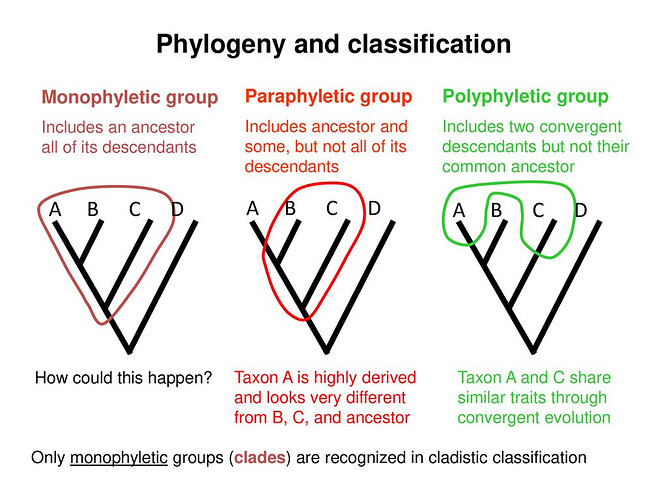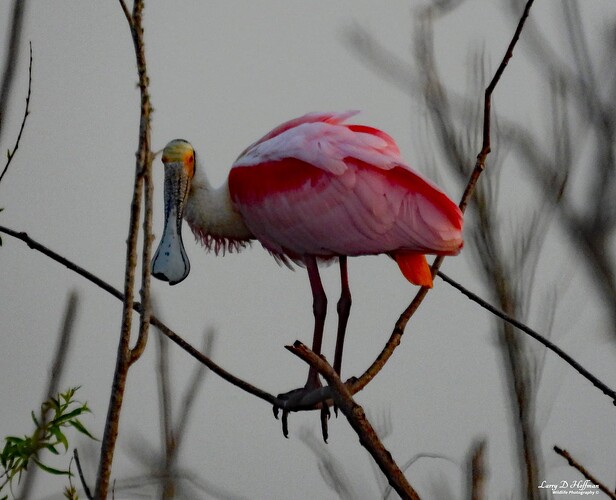Dinosaurs are extinct, or are they? A paleontologist reflects on seeing signs of ancient prehistoric creatures while hiking.
For what it’s worth, the Tree of Life web project has birds within the Coelurosauria clade which also contains T. rex. Coelurosauria is contained within the larger clade Theropoda which are the bipedal predatory dinosaurs.
Assuming we all accept common descent then the first life forms are still represented by their direct descendants, and that includes every living thing. But surely birds would be the nearest living relative of dinosaurs. Even if no creature classifiable as a dinosaur is a direct progenitor of birds, still, wouldn’t it be correct to say some creature(s) which gave rise to dinosaurs also gave rise to birds?
Birds are dinosaurs in the same way primates (hence, humans) are mammals.
A branch of the dinosaur clade gave rise to the birds in the same way a branch of the mammal clade gave rise to primates. A bird is as much a dinosaur as a howler monkey is a mammal.
There are challenges with a strictly modern-cladistic definition of taxa, for instance:
More broadly, asking “Are paraphyletic groups useful in some cases?” is better than the all-too-common “only monophyletic groups are acceptable”. Especially where a common name is involved, (e.g. “fish”) paraphyly is probably fine.
My position is that monophyletic groups are the only objective grouping. The division between paraphyletic groups is arbitrary and subjective. At the same time, arbitrary and subjective groupings can be useful.
Using the same logic, would we then conclude that bats are not mammals? Were pterodactyls not reptiles? Are butterflies not insects?
The issue is groups like, say, non-mammal synapsids or Australopithecus. Ones that were at one time monophyletic, but all but one, or a few, of the major lineages have gone extinct, and those extinct lineages are in many ways more similar to each other than to the modern ones. Thus, they could legitimately be used as monophyletic groups at some point in the past.
OOOH it looks like Colin and @jstump’s favorite office argument: what is a species 
How does a lineage stop being monophyletic? The ancestors don’t change, so they are always the descendants of the same ancestor. A monophyletic clade is an ancestor and all of its descendants.
The scientists in my office are microbiologists, so we have different problems in defining species compared to other scientists who study animals.
The lineage does not cease to be monophyletic, but what I am thinking of is a clade that once had many autapomorphies, but most members went extinct, and the only living subgroup lacks many of those autapomorphies. A group like non-mammal synapsids or non-avian theropods.
Some monophyletic groups would be hard to define based on morphology and some clades will not be as tidy as humans want them to be. This is probably why colloquial and paraphyletic groups are popular because they fit better with human biases.
That is certainly true. I would still consider some grades extremely useful for describing placement of certain, especially fossil, taxa: like Ediacaran to Paleozoic “monoplacophora”, which probably includes ancestors of most modern molluscan classes.
Far more of a nuisance are “We should create a name for every clade” (which is popular for dinosaurs, birds, and mammals, and impossible almost everywhere else), let alone “clade names should refer to the smallest clade that contains everrything they originally contained” (great, now Nautilus becomes a senior synonym of Eukaryota, and most other Linnean genera become senior synonyms of giant clades).
If there is one thing I have learned in the sciences is that nature will often not behave in the way humans want it to. Why can’t biology just behave and fit into easy to understand black and white categories? Why can’t natural history fit into binary processes instead of a mish mash of convoluted histories and mechanisms. Why can’t there be a universal definition of species? Such a cruel mistress.
As another example, I was watching a documentary on the migration of humans into N. America. There were two “competing” theories with one having people move down the Pacific coastline from the Bering Strait, and the other having people walk through the middle of the continent between two ice sheets. At one point in the documentary it donned on me, “Why just one?”. What I also noticed is how long it took me to realize that. In my head, I was already weighing one against the other trying to decide which one was right. That’s human psychology for you.
Things are often far more complex than initially guessed, especially in biology. What I dislike is “We should throw out all the categories for transitionals and unknowns” when they are not at all confidently resolved. People making such statements have obviously not been working on groups like Skeneidae (a wastebasket for tiny marine naticiform snails that needs DNA to resolve, but where DNA is somewhat lacking in broad coverage), Pyramidellidae (it’s monophyly is confident, but figuring out the subgroups needs DNA, and most species are only known from shells), or early Paleozoic stem-members of phyla (often hard to place). Once a group is confidently resolved, then a more cladistic approach is appropriate, but if none of the clades have good support, we should probably use something that is likely paraphyletic, but at least people know what it means.
Between following this discussion and my frustration with the constant changes in the Botanical names of plants I collect and read about, I’ve decided the world of taxonomy, along with that of quantum mechanics, is not one that merits my attention. But thanks to everyone who attends to that so that I don’t need to.
I have looked at most of the words in this discussion between @T_aquaticus and @Paraleptopecten (Is it actually reading, if I grasp nothing?) What I do understand is that I am observing two people with expertise and understanding, who understand each other and do so well enough to disagree and support their own positions.
What I also understand is the ease with which lay people are duped by seeming experts, who can talk gibberish and make it sound like science and scientific discussion. In a mixed and public environment like this one, anyone can participate and call “foul” at any time, when garbage is detected. THAT is highly valuable. People are forced to keep the conversation honest or face public challenges to nonsense.
You are too kind. I will study, when i have a big screen.
And then what I’m talking about is taking the first diagram and modifying it to where B and C went extinct at about the same time, members of D are still around, and the descendants of A look very different now. And in that context, whether a name encompassing A, B, and C, but not the descendants of A is useful.

